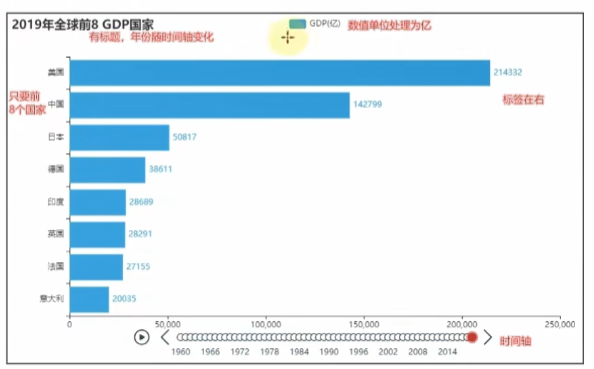数据可视化- 动态柱状图
更新时间: 2024-03-26 23:27:00
# 通过Bar构建基础柱状图
"""
演示基础柱状图的开发
"""
from pyecharts.charts import Bar
from pyecharts.options import *
# 使用Bar构建基础柱状图
bar = Bar()
# 翻转x轴和y轴
bar.add_xaxis(["中国","美国","英国"])
bar.add_yaxis("GDP",[30,20,10], label_opts=LabelOpts(
position="right"
))
bar.reversal_axis()
# 设置数值标签在右侧
bar.render()
1
2
3
4
5
6
7
8
9
10
11
12
13
14
15
2
3
4
5
6
7
8
9
10
11
12
13
14
15
# 基础时间线柱状图
"""
演示带有时间线的柱状图开发
"""
from pyecharts.charts import Bar, Timeline
from pyecharts.options import LabelOpts
bar1 = Bar()
bar1.add_xaxis(["中国","美国","英国"])
bar1.add_yaxis("GDP",[30, 20, 10], label_opts=LabelOpts(position="right"))
bar1.reversal_axis()
bar2 = Bar()
bar2.add_xaxis(["中国","美国","英国"])
bar2.add_yaxis("GDP",[50, 15, 5], label_opts=LabelOpts(position="right"))
bar2.reversal_axis()
bar3 = Bar()
bar3.add_xaxis(["中国","美国","英国"])
bar3.add_yaxis("GDP",[70, 10, 0], label_opts=LabelOpts(position="right"))
bar3.reversal_axis()
# 构建时间线对象
timeline = Timeline()
# 在时间线添加柱状图对象
timeline.add(bar1, "点1")
timeline.add(bar2, "点2")
timeline.add(bar3,"点3")
# 绘图是用时间线对象绘图,而不是bar对象了
timeline.render("基础时间线柱状图.html")
1
2
3
4
5
6
7
8
9
10
11
12
13
14
15
16
17
18
19
20
21
22
23
24
25
26
27
28
29
30
31
2
3
4
5
6
7
8
9
10
11
12
13
14
15
16
17
18
19
20
21
22
23
24
25
26
27
28
29
30
31

# 自动播放
# 自动播放设置
timeline.add_schema(
play_interval=1000, # 自动播放的时间间隔,单位毫秒
is_timeline_show=True, # 是否在自动播放的时候显示时间线
is_auto_play=True, # 是否自动播放
is_loop_play= True # 是否循环自动播放
)
1
2
3
4
5
6
7
2
3
4
5
6
7
# 时间线设置主题
from pyecharts.globals import ThemeType
# 创建时间线对象
timeline = Timeline({"theme": ThemeType.LIGHT})
1
2
3
4
2
3
4
# GDP动态柱状图绘制
# 需求分析
 简单分析后,发现效果图中需要:
简单分析后,发现效果图中需要:
- GDP数据处理为亿级
- 有时间轴,按照年份为时间轴的点
- x轴和y轴反转,同时每一年的数据只要前8名国家
- 有标题,标题的年份会动态更改
- 设置了主题为LIGHT
# 处理数据
- 将数据转换为字典存储,格式为:
{年份:[[国家,gdp],[国家,gdp],....], 年份:[[国家,gdp],[国家,gdp],....],....}
# 完整代码
"""
GDP动态柱状图开发
"""
from pyecharts.charts import Bar, Timeline
from pyecharts.options import *
from pyecharts.globals import ThemeType
# 读取数据
f = open("D:/python/python-learn/资料/可视化案例数据/动态柱状图数据/1960-2019全球GDP数据.csv", encoding="GB2312")
data_lines = f.readlines()
# 关闭文件
f.close()
# 删除第一条数据
data_lines.pop(0)
# 将数据转换为字典存储,格式为:
# {年份:[[国家,gdp],[国家,gdp],....], 年份:[[国家,gdp],[国家,gdp],....],....}
# 先定义一个字典对象
data_dict = {}
for line in data_lines:
year = int(line.split(",")[0]) # 年份
country = line.split(",")[1] # 国家
gdp = float(line.split(",")[2]) # gdp数据
# 如何判断字典里面有没有指定的key呢?
try:
data_dict[year].append([country, gdp])
except KeyError:
data_dict[year] = []
data_dict[year].append([country, gdp])
# 创建时间线对象
timeline = Timeline({"theme": ThemeType.LIGHT})
# 排序年份
sorted_year_list = sorted(data_dict.keys())
for year in sorted_year_list:
data_dict[year].sort(key=lambda element:element[1], reverse=True)
# 取出本年份前8名的国家
year_data = data_dict[year][0:8]
x_data = []
y_data = []
for country_gdp in year_data:
x_data.append(country_gdp[0]) # x轴添加国家
y_data.append(country_gdp[1] / 100000000) # y轴添加gdp数据
# 构建柱状图
bar = Bar()
x_data.reverse()
y_data.reverse()
bar.add_xaxis(x_data)
bar.add_yaxis("GDP(亿)", y_data, label_opts=LabelOpts(position="right"))
# 反转x轴和y轴
bar.reversal_axis()
# 设置每一年的图表的标题
bar.set_global_opts(
title_opts=TitleOpts(title=f"{year}年全球前8GDP数据")
)
timeline.add(bar, str(year))
# 设置时间线自动播放
timeline.add_schema(
play_interval=1000,
is_timeline_show=True,
is_auto_play=True,
is_loop_play=False
)
timeline.render("1960-2019全球GDP前8国家.html")
1
2
3
4
5
6
7
8
9
10
11
12
13
14
15
16
17
18
19
20
21
22
23
24
25
26
27
28
29
30
31
32
33
34
35
36
37
38
39
40
41
42
43
44
45
46
47
48
49
50
51
52
53
54
55
56
57
58
59
60
61
62
63
64
65
66
2
3
4
5
6
7
8
9
10
11
12
13
14
15
16
17
18
19
20
21
22
23
24
25
26
27
28
29
30
31
32
33
34
35
36
37
38
39
40
41
42
43
44
45
46
47
48
49
50
51
52
53
54
55
56
57
58
59
60
61
62
63
64
65
66
